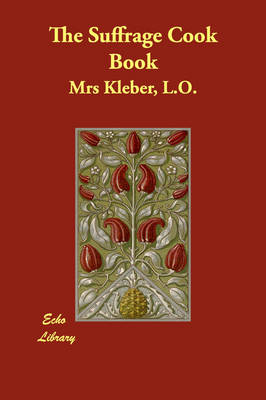Politics and cooking have a long history together
February 27, 2020 by DarcieIf you are following the US presidential candidate primary, you may have seen Pete Buttigieg’s controversial salsa/ranch dressing mashup, or perhaps viewed Stephen Colbert talking with Elizabeth Warren over a meal featuring traditional foods of South Carolina. Combining food and politics did not begin with these events, of course. There is a long history of food and politics being intertwined, whether through politicians glad-handing their way through crowds at county fairs or coming together over a meal to hammer out a legislative deal. Women played a role in this process as well, as Sydney chef Liz Mason discovered. She found an 1886 cookbook titled The Woman Suffrage Cookbook and was fascinated by what she discovered inside.

Enamored by the stories and recipes in this Boston-based book and a similar UK tome titled The Women’s Suffrage Cookery Book, Mason decided that she had to make a meal using recipes from the volumes. During the suffragette movement, these books were used as fundraising devices and featured recipes from women involved in the movement. (The book pictured here was from that era but is neither of the books described above.)
Mason has spent the past six months poring over the cookbooks, choosing and adapting eight recipes that she will serve at an International Women’s Day dinner on March 7. Deciphering the sparsely-detailed recipes was no mean feat, says the chef. “You need to have an understanding of how to cook to interpret [them],” she explains. The measurements are not standardized either, with things like “loaves of sugar” adding to the challenge.
Not only is Mason going to serve dishes from these vintage books, she and her team will be making them just as they did when the books were written. That means no modern appliances: her staff will be performing tasks such as churning butter by hand. Even though the women writing in the 1880s did not have fancy gadgets, they did develop ingenious methods that Mason is putting to work today, like using gelatin to stop sorbet from separating.
Categories
- All Posts (6940)
- Antipasto (2135)
- Author Articles (247)
- Book News (935)
- Cookbook Giveaways (983)
- Cookbook Lovers (257)
- Cooking Tips (109)
- Culinary News (299)
- Food Biz People (552)
- Food Online (791)
- Holidays & Celebrations (272)
- New Cookbooks (149)
- Recipes (1500)
- Shelf Life With Susie (231)
- What's New on EYB (133)
Archives
Latest Comments
- Atroyer7 on Danube Cookbook Review and Giveaway
- demomcook on What foods do you look forward to the most for each season?
- demomcook on Danube Cookbook Review and Giveaway
- Darcie on How cookbooks can help build resilience
- mholson3 on Danube Cookbook Review and Giveaway
- Rinshin on How cookbooks can help build resilience
- sarahawker on Danube Cookbook Review and Giveaway
- Sand9 on Danube Cookbook Review and Giveaway
- hankintoby29 on Heritage Cookies of the Mediterranean World – Cookbook Giveaway
- WBB613 on Feasts of Good Fortune Cookbook Giveaway